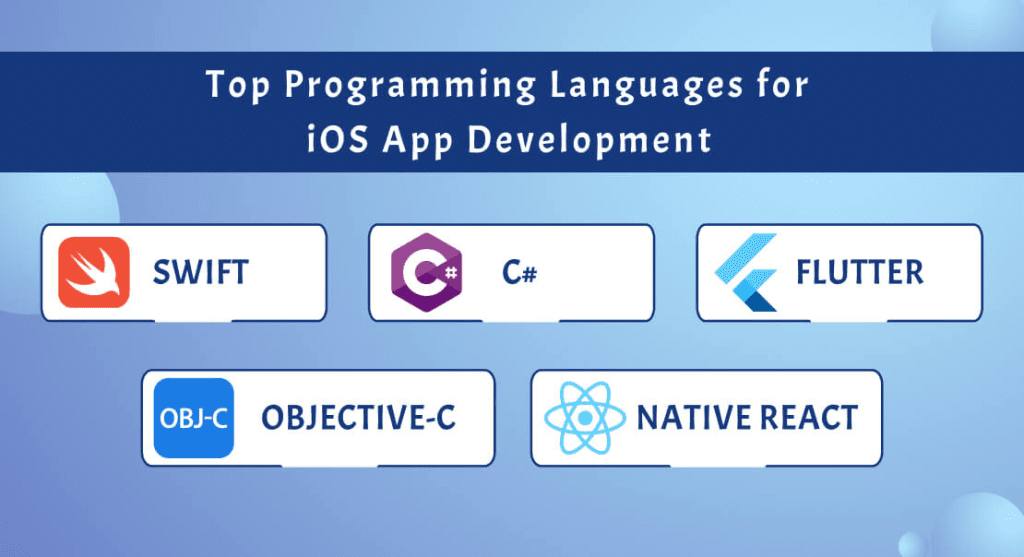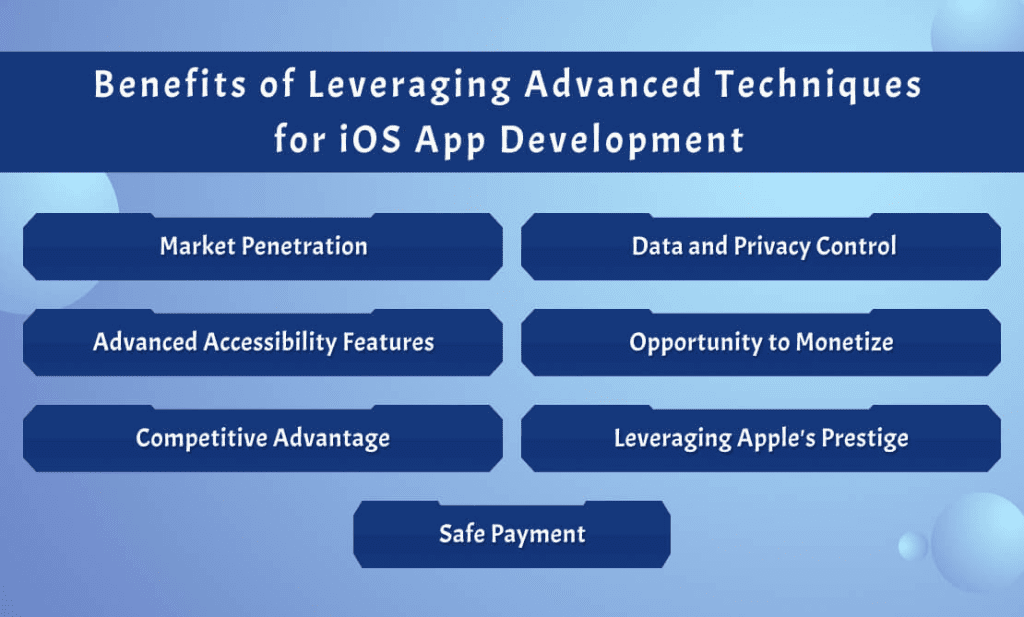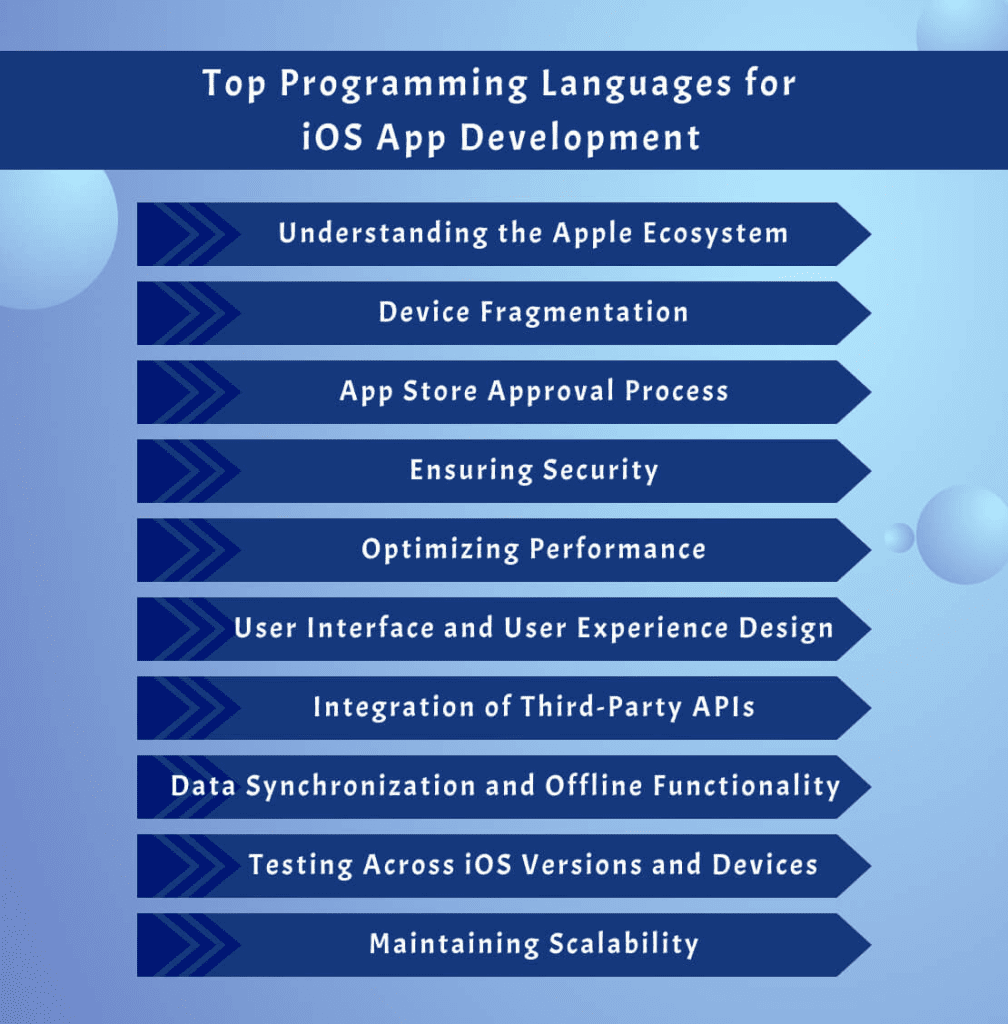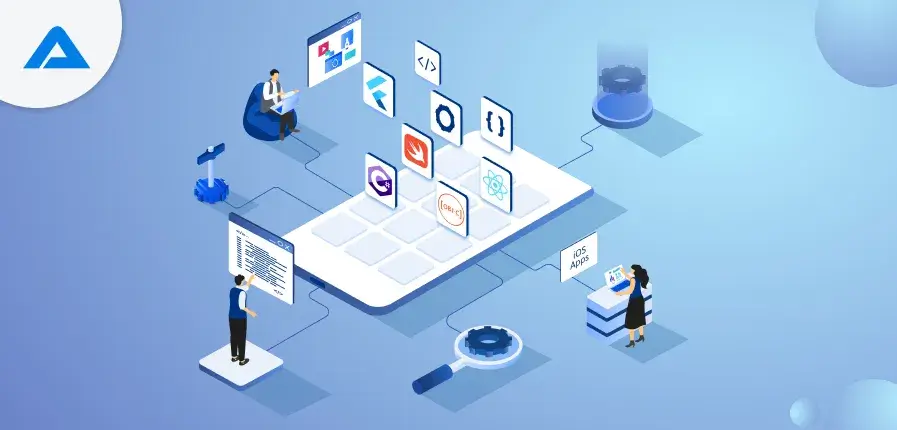Technology has seen an ever-growing pace of technological advancement and innovation, affecting all industry sectors. This is why it is no surprise that the iOS Programming Language is among the numerous innovations in the tech sector.
If you’re currently reading this blog post on your computer, you’ll likely be reading it via the internet, mobile phone, or laptop. These screens are vital to our business and our lives. According to research from Hitwise, 60% of internet-related searches take place on smartphones, and the remainder are divided between tablet and desktop computers.
There are currently over one billion iOS users worldwide, and the numbers are projected to grow exponentially, as per data provided by AppMySite. Its growing popularity and faithful customer base have allowed it to exceed this number. Therefore, iOS is a game-changing technology. Thus, with no further delay, let’s begin.
This article will take you into the details of utilizing advanced techniques to create an iOS application. Other crucial areas include iOS programming languages, coding, and more. They are also going to be covered.
What is the iOS Programming Language?
iOS programming language is the language set used for developing apps for Apple mobile devices, including iPhones, iPads, iWatch, and Apple TVs. Swift is the most popular and favored programming language used for iOS application development. Swift.
Although Swift has been deemed the best option, Objective-C remains relevant and is still utilized in current iOS projects and when working with older codebases. iOS application developers can use both languages in one project, which allows an easy transition and gradual acceptance of Swift.
We now clearly understand which iOS programming languages are, so let us focus on a more vital feature, i.e., top programming languages suitable for iOS app development.
Top Programming Languages for iOS App Development

Although Apple’s App Store allows the creation of millions of apps each year for users of the iOS platform, the process of creating them can be challenging. There are specific guidelines, checklists, languages, and a set of rules that an iOS developer must adhere to to start. We are ready to reveal the best programming languages to help with iOS development.
1. Swift
Swift is a popular and commonly used programming language to create iOS iPads macOS, WatchOS, and itvOS. It is among the more precise and natural dialects of this language, Swift. In addition, Swift’s syntax can be described as simple, expressive, and interactive. Swift incorporates the latest features that developers love.
It is a high-speed and secure software development platform through design. Computer language was created with security in mind and could avoid whole classes of unsafe code. The high-speed LLVM compiler technology transforms Swift code into machine code designed to exploit the latest hardware fully.
Language is a way to gain access to the computing world; in fact, the language was developed to be an essential beginning to learning programming. For expert assistance with Swift app development, you can count on us.
Features
- Swift’s code is versatile, robust, and user-friendly.
- It determines the instances that are no longer used and removes them with Automatic Reference Counting (ARC).
- It allows applications to produce several values.
- In qualifying for types to be utilized as parameters, generics assist in identifying programming errors.
2. C#
Microsoft developed the general-purpose computer technology called C#, which was first available in the year 2000. Many kinds of C# include C#, ASP/ASP.NET, Microsoft Xamarin, MonoDevelop, and others. It is mainly used for the creation of Windows applications.
It was initially implemented by Xamarin technology, an open-source toolkit that allows developers to create Android, iOS, Windows, and MacOS applications. To develop unique web applications, C# development services will help you get established quickly.
The language can create desktop applications for Windows using Visual Studio code available on GitHub for MacOSX using Xamarin Studio. It is possible to share code among devices by using their SDKs, and C# games are also accessible from within Visual Studio Code itself. Let’s briefly overview some of the most essential features C# offers.
Features
- It helps prevent errors through the ability to manage the mistakes systematically and rationally.
- It is a strong advocate for object-oriented programming and also provides classes.
- It handles the management of memory at a low level.
- It makes use of Generics that can be utilized to address the specific areas of the application that require changes.
- C# manages to blend the programming capabilities of several languages into one.
- It could be more efficient in its performance than other languages; However, it has an extended life span due to being fully supported by Microsoft.
3. Objective-C
Objective-C is a programming language developed through the Objectives Computing Corporation in the 1980s. It was created to facilitate programming. Additionally, it is one of the most popular iOS programming languages for apps. Objective-C has attracted much attention in programming, mainly from Apple users.
It is described as a compact but compelling collection of enhancements to the primary ANSI language. The first of languages that was object-oriented, Smalltalk, was the main inspiration for the addition to C. Therefore, let us examine why C is among the top well-known and influential languages for iOS application development.
Features
- It is an advanced compiler that can support hardware acceleration and is much faster than other frameworks for programming.
- It is compatible with C and C++ as well as Objective-C programming languages. We are making it easy to build cross-platform apps.
- Access to methods and classes has separated from the programming syntax.
- It could be a scripting system for writing scripts that includes automated memory management functions, such as garbage collection.
- The types of data that are that are regulated by garbage collection may utilize it.
4. Flutter
If you had to learn one that’s exceptionally speedy and can adapt to the digital age of this century without a doubt, Flutter is the perfect choice. Users can see all recent changes without losing vital information as it offers a simple experience with rapid refresh. However, there are instances when you’ll wonder whether Flutter is the best option for new businesses. This is our blog, which helps you understand this question and make the most appropriate decision.
Flutter app development agency is built on the language of programming Dart, created by Google in 2009 and improved over time. Apps that are cross-platform designed for Android, iOS, Linux, macOS, Windows, and Google Fuchsia can be created using Flutter.
Features
- It allows for fast compilation time without sacrificing the quality of code.
- It displays consistently on iOS and Android devices.
- It can create applications in the shortest amount of time because rendering works similarly for iOS and Android.
- Maintenance of code is more straightforward to handle because it utilizes the same language for creating applications for both platforms.
- It is based on Google’s Dart programming language, which is a breeze to master and use, which helps make the Python comparison somewhat.
- It utilizes a swift compiler compatible with hardware acceleration and is much faster than other frameworks for programming.
- It can support C and C++. It also helps C, C++, and Objective-C Programming languages, simplifying the development of cross-platform applications.
- The ability to access methods and classes separated from the programmers” syntax.
- It could be a scripting system for writing scripts that includes automatic memory management functions, such as garbage collection.
- The types of data that are controlled by garbage collection could be utilized.
5. React Native
To be used on iOS platforms, it’s often used to create applications. It is offered by Meta, which has a vast number of users. It is possible to publish your app on the Android platform by using React. In addition, it’s the first choice for programmers looking to build iOS applications since it’s one of the simplest programming languages to master.
The fundamental technology revolves around displaying views on both platforms using JavaScript instead of native C++ and Swift code, making it easier to make your app available to any platform. For expert assistance in developing React Native apps, you can count on the experts and receive the most efficient support. So, let’s look at some attributes that make React Native different from other iOS application programming languages utilized to develop iOS applications.
Features
- It can be used to make native mobile apps that cross-platform and use the same code for each iOS and Android.
- It is compatible with auto-layout and Flexbox, which makes the creation of dynamic layouts a breeze.
- When using React Native, the components are the focus and can communicate.
- It is equipped with numerous third-party tools that could be used to accomplish various things.
Things to Consider Before You Start Working on Your iOS App
When creating a stunning iOS application, you must understand that it must be studied and designed. Before you start designing your iOS application, there are some things to consider.
1. Define Its Purpose
Before starting, take a moment to think about why you chose to create your application and attempt to answer a few of the questions, such as what requirements of the person whom your app will satisfy, why you’re planning to build this app, and the similar applications available on the Market.
When you answer these questions by answering these questions, the app’s presentation to users will be more easily accessible. Additionally, you’ll be able to evaluate plans for the development of apps more effectively.
2. Conduct due diligence on the Market
This stage plays an essential part; however, numerous organizations need to remember or do this step. To get people to download and get the most out of your app, it is necessary to learn more about them. To better understand this, you need to conduct surveys and build an account of the person who will download your application based on factors like age, nationality, and sexual orientation.
These steps allow the creation of a unique marketing strategy to maximize the number of downloads.
3. Create a Detailed Plan for Your iOS App Development
After analyzing the reason and conducting research, you should consider the plan and make sure it’s as precise as you can and contains all the necessary details. You’ll need to ask a couple of questions before you begin the process of planning. You must be able to answer these questions: which technology is the best choice to develop an app? What are the details of the interface? How do you assess the app’s performance, and what security concerns are you considering when developing the application?
4. Take into consideration compatibility with multiple iOS Versions
Remember, not all iOS users regularly update their devices when developing an iOS application. Therefore, it is essential to consider interoperability. Occasionally, your app works with the latest version, but the user is using an older version. The likelihood is that your user will be frustrated and deleting the application.
Thus, it would be best to concentrate on creating your application to be compatible with all system versions.
5. Evaluate Your Internal Capabilities to Build This App
The time and cost factors are influenced by their complexity and utility. Be sure that the team chosen has experience in constructing the app, market data, and knowledge.
Benefits of Leveraging Advanced Techniques for iOS App Development

Here are a few benefits of employing advanced techniques in iOS app development:
1. Market Penetration
Apple is regarded as the world’s most significant brand, with a value growth of 74%, up from 219 to 517 billion US dollars. The unequal strength of the Apple brand offers stakeholders and developers the possibility to enter the Market of advanced countries, embracing every Market on the planet with a revolutionary strategy.
2. Data and Privacy Control
With the most sophisticated and secure tools, such as app transparency for tracking (ATT) and privacy nutritional labels that allow you to communicate with your data privately, iOS app development takes privacy and data control to a new level.
On the other hand, nutrition privacy can help transparency in managing data since it ensures app developers reveal the nature and purpose of any data collected.
3. Advanced Accessibility Features
The integration of several accessibility features, such as VoiceOver (a Screen reading option), Dynamic Type (a font-size change feature), Assistive Touch (used to control the movement of people with motor disabilities), etc., makes your iOS-developed apps available to all, no matter the category of health they fall into.
Furthermore, not only will these sophisticated accessibility features increase your database of users, but they’ll also help you develop an iOS application that is durable and accessible to all.
4. Opportunity to Monetize
There are a variety of streams that you can use to earn income and monetize your iOS application. These include streams like subscriptions, ads, and in-app purchases. They can also help you increase your income and revenue goals as an entrepreneur or business owner.
5. Competitive Advantage
A well-designed and robust iOS application will set your brand apart and create differentiation for your product. As the owner and developer, this allows you to gain an edge over your competition.
6. Leveraging Apple’s Prestige
Accepting an app into the App Store is a complicated process, as only apps that have been thoroughly tested are accepted for uploading to the App Store. This has been proven and is a part of the consciousness of each iPhone user. As such, whenever they see any app in the App Store, they think it is worth their time and effort.
7. Safe Payment
An iOS programming language provides users an encrypted and secure transaction platform without worrying about dangers like phishing, hacking, or other cyberattacks.
Overcoming Challenges Faced When Creating an iOS App

Developers frequently face many obstacles that require a lot of creativity, skill, and determination to get over. This article outlines some of the typical challenges encountered during the iOS application development procedure development and provides strategies for navigating them efficiently.
Understanding the Apple Ecosystem:
Apple’s ecosystem is distinctive and has strict guidelines, programming languages like Swift, and other tools like Xcode. Developers have to adapt to this environment, which can be challenging, particularly for those who are used to other operating systems. Understanding Apple’s Human Interface Guidelines (HIG) is vital to ensure that the app is in line with Apple’s design principles. Being up-to-date with Apple’s latest technology and updates is essential to make the most of the new features and upgrades.
Device Fragmentation:
iOS devices differ regarding resolutions, screen sizes, and features. Making an app that works seamlessly across iPhones, iPads, iPhones, and other iOS variations can be challenging. Implementing the principles of responsive design and strategies for adaptive layouts can allow apps to be adapted to screen sizes of different dimensions, ensuring users have a consistent experience.
App Store Approval Process:
The App Store follows strict guidelines to ensure security and quality. The application acceptance and submission process could take a long time. Developers frequently need help with rejected applications because of non-compliance with the guidelines. To resolve this issue, thorough testing, adhering to the guidelines, and promptly addressing feedback are essential. Being aware of App Store guidelines and interacting effectively with Apple’s review staff can simplify the approval process.
Ensuring Security:
Security is a significant factor in iOS’s development of apps. The protection of user data, as well as the app’s security against security vulnerabilities, requires an active approach. Developers should adopt certain code practices, employ encryption techniques, and frequently upgrade the app to fix security holes. The Apple security guidelines and authentication mechanisms provide an additional security layer to protect against dangers.
Optimizing Performance:
The ability to achieve optimal performance while ensuring an enjoyable user experience is an ongoing issue. Managing memory, efficient code, and limiting the use of resources are crucial to preventing delays and crashes. Conducting thorough tests on different devices and analyzing performance metrics can help you find and eliminate bottlenecks—the profiling tools available in Xcode aid in enhancing code and improving your app’s overall performance.
User Interface and User Experience Design:
Making a user-friendly and visually appealing user interface that fits Apple’s design philosophies is an ongoing challenge. Balancing aesthetics with function requires collaboration between developers and designers. Testing with users and taking feedback from users in the design phase will improve the interface and enhance the users’ overall experience.
Integration of Third-Party APIs:
Many iOS applications rely on third-party APIs to provide features such as authentication, maps, and Social media connectivity. However, integrating these APIs may create challenges, such as version compatibility problems, security concerns, and changes in API Development specifications. Researching thoroughly, selecting the most trustworthy APIs, staying abreast of changes, and ensuring correct error handling will help overcome the challenges.
Data Synchronization and Offline Functionality:
Creating apps that seamlessly sync data across devices and work offline is a matter of careful thought. Implementing a robust mechanism for data synchronization and using technologies such as Core Data to provide adequate offline data storage could solve these problems. Smooth transitions between offline and online modes will make the app more user-friendly.
Testing Across iOS Versions and Devices:
Testing is an essential element of iOS app development, and ensuring compatibility between the various iOS versions and platforms is a huge problem. Implementing automatized testing software, creating extensive test cases, and maintaining a varied testing environment for devices will allow you to identify and solve issues with compatibility early in your development.
Maintaining Scalability:
When an app becomes widespread, it becomes a problem to scale. Managing an ever-growing user base without compromising performance demands meticulous planning. Implementing scalable server architecture, optimizing backend service performance, and monitoring usage patterns will help developers anticipate and tackle scalability concerns.
Conclusion
Making iOS applications requires extensive preparation and a thorough understanding of certain fundamental principles and rudiments. In this blog, we’ve delved into explaining what iOS programming is about, the advantages of using advanced methods to aid in iOS app development, the top 10 most influential programming languages for native iOS mobile applications development, and what to look for before launching.
The most suitable programming language for iOS applications could be a challenge because Apple’s requirements and limitations are constantly changing. Continuous monitoring and checking compliance by developers is mandatory. If you’re looking to create a successful app, register your app listed on the app store, or make the app available to sell elsewhere, it is recommended to consult a professional to develop your mobile app.
